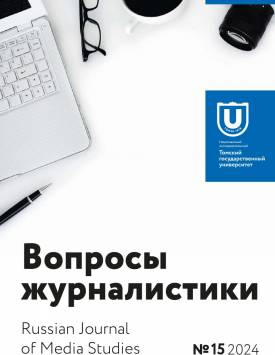Environmental journalism of the Southern Urals: Some features of the perception of modern content by the youth audience
The aim of the article is to analyze some of the key problems, in the author’s opinion, that modern domestic environmental journalism faces in its development. Such problems include, first of all, those related to the creation of methodological structures that make it possible to effectively scientifically investigate the processes taking place in domestic environmental journalism in particular and in the media space in general. The article emphasizes the importance of continuing work on the concept of “media text” within the framework of the concept of “multimodality”, which in turn should be refined taking into account the special role that artificial intelligence technologies play in modern journalism. The author of the article considers one of the main problems for modern environmental journalism to be the insufficient number of studies on the reactions of different groups of the population to the processes taking place in the modern media sphere, which significantly complicates the scientific assessment of the effectiveness of many modern media, including those dealing with environmental issues. The article presents the first results obtained by a group of scientists from South Ural State University during the implementation of a project dedicated to the impact of media materials, social media on ecology and media effects on the youth audience living in an environmental risk region. Within the framework of this project, methods previously successfully tested in neuromarketing research are widely used. Based on the conducted research, the author of the article comes to three main conclusions. Firstly, it is necessary to further improve the methodological approaches used by researchers of the modern media space in general and environmental journalism in particular. The creation of a single universal methodology for such research today looks like a difficult task to solve (if at all having an unambiguous rational solution). Much more promising is the way of forming unique methodological structures, which will allow us to more fully understand the specifics of the subject of research. Secondly, the first signs of an emerging significant gap between the technological modernization of media texts and the ability of significant groups of consumers of these texts to adequately respond to changes in the form of submission of materials prepared by journalists have been recorded. This problem is particularly acute due to the increasingly active use of artificial intelligence technologies in shaping the information agenda and visual images. Thirdly, eye-tracking research, supplemented by classical methods for studying the media space at the turn of the century (surveys, focus groups, interviews, etc.), gives very interesting results for understanding the effectiveness of media exposure to the youth audience, but the methodology of these studies needs further improvement. The author declares no conflicts of interests.
Keywords
eye tracking, cognitive approach, media text, multimodality, environmental journalismAuthors
| Name | Organization | |
| Sibiryakov Igor V. | South Ural State University | sibiriakoviv@susu.ru |
References

Environmental journalism of the Southern Urals: Some features of the perception of modern content by the youth audience | Voprosy zhurnalistiki – Russian Journal of Media Studies. 2024. № 15. DOI: 10.17223/26188422/15/3
